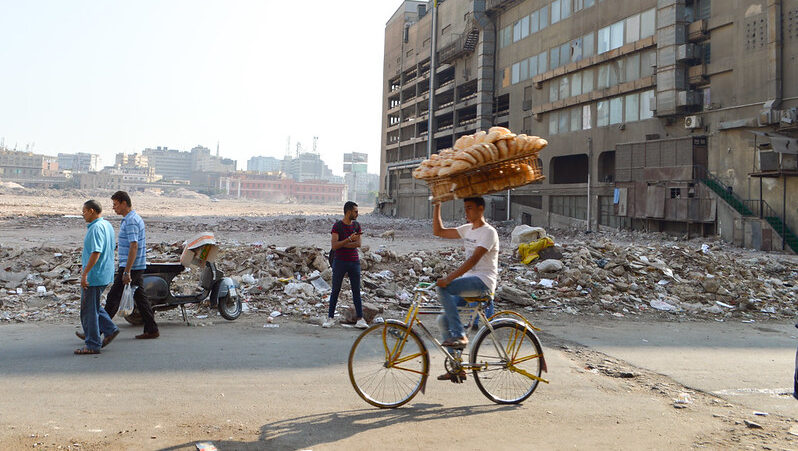Russia’s war on Ukraine has thrust food security to the top of the global agenda. Now, the world’s leading climate scientists have piled on a stark warning: Unless we act fast, climate change all but ensures that food crises will become the norm and not the exception.
The combination of acute shocks to global food systems and a warming climate make for a terrifying and explosive combination. We are seeing the consequences play out right now, as the war in Ukraine will almost certainly trigger a global food crisis with catastrophic consequences for the most vulnerable.
Ukraine and Russia are both agricultural powerhouses, and together account for nearly a third of global wheat and barley exports. 45 African and least developed countries import at least a third of their wheat from Ukraine or Russia, and 18 of those countries import more than half. If the war drags on, countries like Egypt could face food shortages as soon as this summer, triggering what the UN secretary general has warned could become “a hurricane of hunger and a meltdown of the global food system”.
Then there’s climate change. One of the most alarming findings in the Intergovernmental Panel on Climate Change’s (IPCC) recent series of reports is that the climate crisis will increasingly undermine food security and nutrition around the world. The IPCC’s report on climate impacts confirmed that extreme climate events like floods, droughts, and storms have already exposed millions to acute food insecurity and malnutrition.
IPCC: Five takeaways from the UN’s 2022 climate impacts report
Perhaps most ominously, the IPCC warns that climate extremes will increase the risk of simultaneous crop losses in major food-producing regions, with potentially catastrophic consequences for food prices and availability.
This is our new reality: A gradually worsening situation for food and nutrition as temperatures relentlessly rise. It’s the frightening backdrop for the world’s geopolitical and economic developments – any crisis in a critical food-producing area could spell disaster on a global scale.
While it’s likely too late to prevent a food crisis in Ukraine, we can help those who are suffering now while working to aggressively reduce our greenhouse gas emissions and build resilience to future food shocks.
First, we must respond to the growing humanitarian emergency. The World Food Programme’s work is critical and should be fully funded, along with the full UN-wide response.
Second, governments should collectively diagnose the challenges to food security and coordinate their responses. When G7 countries gathered in Brussels in late March, they committed to acting in unison and called for an extraordinary session of the Council of the Food and Agriculture Organization to address the consequences of Russia’s invasion for global food security and agriculture. They should follow through on those commitments.
Sweden set to be world’s first country to target consumption-based emission cuts
Third, critical ecosystems should not be turned into farmland to make up for Ukrainian and Russian food exports. As part of its emergency plan, the EU is considering freeing up fallow and conservation land for increased grain production. The United States Department of Agriculture made the right call when it rejected a request to let farmers plant on land protected through its Conservation Reserve Program. Europeans should follow suit.
Fourth, we can make up for lost food production by minimizing the amount of crops used for animal feed and biofuels. The U.S. uses more than a third of the corn it produces for ethanol to blend with gasoline. The World Resources Institute found that reducing grain currently used for transportation in the US and Europe by 50% this year could make up for the shortfall of Ukrainian wheat, corn, barley, and rye. Let’s prioritize growing crops to feed people, not produce fuel.
Similarly, shifting to more sustainable diets could have a big impact. About a third of global cropland is used to feed livestock. Greenpeace estimates that reducing the use of cereals for animal feed by 8% in the EU would outweigh expected production deficits in Ukraine. And we can make more food available for human consumption by reducing food loss and waste, which accounts for a third of all food produced.
Finally, and most importantly, we need to align our global climate and food goals. A changing climate will require resilience across food systems – from agricultural production to food consumption and waste disposal. At the same time, land offers opportunities to reduce greenhouse gases – from implementing farming practices that sequester carbon in soils to reducing agricultural methane emissions from livestock, rice production and food waste, and cutting nitrous oxide emissions from fertilizer overuse.
We are at a pivotal moment. Making the right choices about food – especially the difficult ones – can help minimize human suffering. But if our responses are not aligned with our long-term climate objectives, this food security crisis will not be the last.Ryan Hobert is the managing director for climate and environment at the United Nations Foundation.
